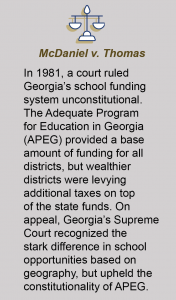 The state of Georgia has a constitutional obligation to provide every child with an “adequate public education.”[1] Over the past 50 years, almost every state’s funding laws have been created or changed in response to lawsuits alleging that schools are either not funded enough (adequacy challenges) or not funded fairly (equity challenges). Georgia lawmakers enacted the current funding legislation, the Quality Basic Education Act (QBE), in 1985, after a lawsuit claimed that rural, low-wealth school districts were not given the same access to educational opportunities as their wealthier district counterparts.[2]
The state of Georgia has a constitutional obligation to provide every child with an “adequate public education.”[1] Over the past 50 years, almost every state’s funding laws have been created or changed in response to lawsuits alleging that schools are either not funded enough (adequacy challenges) or not funded fairly (equity challenges). Georgia lawmakers enacted the current funding legislation, the Quality Basic Education Act (QBE), in 1985, after a lawsuit claimed that rural, low-wealth school districts were not given the same access to educational opportunities as their wealthier district counterparts.[2]
How Does the State Help Low-Wealth Districts?
The amount districts can raise through property taxes varies significantly depending on the value of property. When these local taxes make up a significant portion of the school system’s budget, that difference can be thousands of dollars per student. Georgia’s funding formula includes a grant to make sure districts across the state can offer comparatively similar opportunities regardless of property wealth: equalization grants.
 A Necessary Program, Underfunded Over Time
A Necessary Program, Underfunded Over Time
Equalization grants provide much-needed financial relief to many Georgia school districts. When first created, the state equalized up to the 90th percentile of districts. Put simply, this means that the state gave extra funds to less wealthy districts to help them reach the wealthiest district’s funding levels. In 2000, the legislature changed the benchmark to the 75th percentile. During the Great Recession lawmakers capped equalization funding from FY 2010 to FY 2013 before changing the calculation altogether to where it sits currently[3]—the state average after removing the top and bottom 5% of districts. The cumulative effect of these changes has given school districts billions of dollars less than they would have gotten otherwise.[4]
Policymakers did not enact equalization because of an abstract idea of fairness. On the contrary, these grants have come to represent Georgia’s constitutional commitment to providing an adequate education to all students. As a result, lawmakers should protect and bolster these grants and think creatively about other options that help ensure equitable outcomes for Georgia’s young people.
Download the Equalization Grants Fact Sheet
[1]O.C.G.A. Article VIII, § 1
[2]Cornelius, L. M., & Robinson, C. B. (2006). Rural school districts and the fight for funding adequacy: The legal challenge of “CASFG v. State of Georgia”. Journal of Education Finance, 32(1), 71-88.
[3]Johnson, C. (2013). Bill analysis: House Bill 824. Georgia Budget & Policy Institute.
[4]See: Johnson, C. (2013). In 2013 alone the change in equalization provided districts $340 million less than in the previous calculation.








